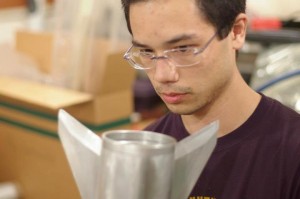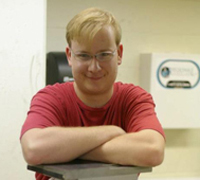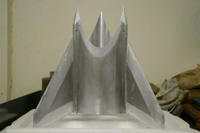Students Target N5800 Rocket Record
September 13, 2012Physics major Chris Cotner ’13 and engineering major Carlo Vaccari ‘13 hope to break the N-class motor altitude record this weekend when they launch their custom-designed, supersonic rocket.
Built over the summer at Harvey Mudd College, the rocket was created in response to the “Fly the N5800 to a Record Contest” announced last spring by rocket motor manufacturer Cesaroni Technology Incorporated (CTI).
Large by hobbyist standards, the N5800 motor will burn for about three and a half seconds, have an average thrust of 1200 pounds and hurl the rocket up to a peak speed of 3.7 times the speed of sound.
“A major challenge is keeping the rocket from melting and breaking up under such tremendous velocity and dynamic pressure,” said physics Professor Greg Lyzenga ’75, who served as the students’ mentor. “A number of college groups across the country have taken up the challenge ever since CTI announced it, but no individual or group has yet succeeded in building a high-performance, minimum-diameter rocket that survived the force of their N5800 motor.”
Vaccari and Cotner’s craft need only top 43,000 feet to break the existing N-class altitude record, but the students’ rocket may soar twice that high, Lyzenga said.
Named “Bare Necessities,” because it consists only of parts essential for recovery, data collection and aerodynamic stability and streamlining, the rocket was specifically designed to meet the demands placed upon it.
“Every person who has tried for the N record using this particular motor has shredded their rocket. Our advantage is that we’re approaching it from a rational perspective based in our engineering, physics and machining backgrounds,” said Cotner, who served as the rocket’s primary fabrication engineer. “We designed every part for this application and manufactured them ourselves when our ideal designs didn’t match existing products.”
Key components of their rocket include a nosecone layup—designed by Vaccari using an ablative thermal protection system developed by Cotner—and a machined fincan, which exists as a solid piece compared to the bolted or welded fins employed by failed rockets.
The team will launch their rocket Sept. 15 in Nevada’s Black Rock Desert, northeast of Gerlach. An official from Tripoli Rocketry Association will serve as a witness to the rocket’s launch and return, confirming whether it remained in flyable condition. A GPS receiver in the rocket will transmit altitude data, which will be saved on a flash drive and used by the Tripoli witness as proof of the altitude reached.



